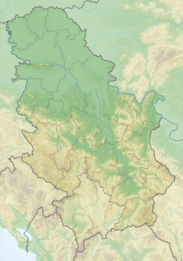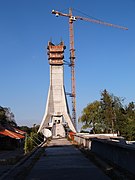Avala TV tower
|
Avala TV tower
Авалски торањ
|
|||||||||
|---|---|---|---|---|---|---|---|---|---|
| Basic data | |||||||||
| Place: | Voždovac | ||||||||
| District: | Belgrade | ||||||||
| Country: | Serbia | ||||||||
| Altitude : | 436 m. i. J. | ||||||||
| Coordinates: 44 ° 41 ′ 46 ″ N , 20 ° 30 ′ 52.1 ″ E | |||||||||
| Use: | TV tower , telecommunications tower , radio transmitter , observation tower | ||||||||
| Accessibility: | TV tower open to the public | ||||||||
| Owner : | JP Emisiona tehnika i veze (ETV) | ||||||||
| Tower data | |||||||||
| Construction time : | 2006-2009 | ||||||||
|
|||||||||
| Operating time: | since 2010 | ||||||||
| Total height : | 204.68 m | ||||||||
| Total mass : | 5800 t | ||||||||
| Data on the transmission system | |||||||||
| Last modification (antenna) : | May 25, 2015 | ||||||||
| Waveband : | FM transmitter | ||||||||
| Radio : | VHF broadcasting | ||||||||
| Send types: | DVB-T2 , directional radio | ||||||||
|
|||||||||
| Position map | |||||||||
|
|
|||||||||
The Avala TV Tower ( Serbian Авалски торањ Avalski toranj ) is an approximately 205 meter high TV tower in the Serbian capital Belgrade . The tower is open to the public and has a viewing platform at a height of around 120 meters. The television tower, built in the 1960s, was destroyed by NATO aggression in 1999 in the course of the Kosovo war . It was rebuilt from 2006 to 2009.
history
First television tower
The first Avala television tower, named after the Avala mountain of the same name on which it stands, was planned and designed between 1959 and 1960 and built from October 14, 1961 to 1964 by a Belgrade construction company. The architects of this tower were Uglješa Bogdanović and Slobodan Janjić, and the chief engineer was Milan Krstic.
Over 100 construction workers were permanently on the construction site and built over 4000 tons of reinforced concrete. The completion of the work was the installation of the 60-meter-high and 25-ton antenna carrier. The commissioning took place in May 1965. The construction work ran without fatalities or serious injuries to the construction workers. The total height of the first television tower was 202.87 meters. This made it one of the tallest television towers in the world when it opened .
In 1971 the antenna of the television tower was replaced by a new one that could transmit color television . It was thus possible for the second program to begin broadcasting the program in color from December 31, 1971.
Destruction of the tower
On April 29, 1999, this tower was destroyed by a bombing raid by American bombers from Operation Allied Force on behalf of NATO during the Kosovo war. The television tower is the world's tallest building that has been destroyed by a war. The destruction was caused by a laser-guided GBU-27 bomb that destroyed one of the tower bases, causing the entire structure to collapse. The structure was one of the last targets to be destroyed by the NATO operation. The purpose of the destruction was to permanently prevent the radio station Radio-Televizija Srbije from broadcasting its programs.
Second television tower
In 2004, an initiative of radio journalists was formed to rebuild the television tower. It began with a collection of funds for the reconstruction, in which the Serbian tennis stars Novak Đoković and Ana Ivanović participated. “Tower concerts” were also organized for this purpose. Through fundraising and private donations euro could be collected in this way over a million. However, the majority of the construction costs, which cost around 85 million euros, were borne by the state.
- Construction progress of the television tower
The current Avala television tower was built from December 21, 2006 to October 23, 2009 and is 204.68 meters high. It replaced the first, almost identical television tower that was built on this site.
The opening ceremony for the new television tower took place on April 21, 2010. Among the guests was the then Mayor of Belgrade Dragan Đilas .
description
Construction and tower shaft
The reinforced concrete structure rises 136.65 meters high, on which there is still a 67.92 meter high antenna carrier.
The tower , built as a vertical cantilever construction , has three load-bearing stilts that support the tower shaft and thus a load of 330 tons. Since the tower shaft does not touch the ground directly, a four meter wide, sloping ramp construction enables access to the tower shaft. The reinforced concrete stilts, which function as tower feet, form an equilateral triangle when viewed from above and are reminiscent of a tripod . At the intersection of the stilts, on the lower part of the shaft, there is a partially glazed entrance hall into which the sloping ramp construction ends. Two high-speed lifts lead from the hall to the upper part of the tower. An architecturally similar solution was also implemented for the St. Chrischona television tower near Basel in Switzerland . In this case, however, the shaft protrudes down into the ground, even if this would not have been necessary for static reasons.
Tower cage
The tower cage , which extends from 102 to 135 meters, consists of two structurally separate units and has a hexagonal base.
The lower single-storey tower cage serves as a service floor and widens slightly towards the height. Above this is an antenna platform on which directional radio antennas are located. Above this is a two-storey basket at a height of around 120 meters, which tapers slightly towards the top. A visitor café and the closed viewing platform for visitors are housed here. Above that there is an open-air platform, which is completely closed off with high panes of glass. There are two additional antenna platforms above the open-air platform. The concrete shaft ends above the second platform and serves as the basis for the final antenna mast.
The reconstructed structure is 204.68 meters high with antenna support and thus almost two meters higher than the original tower.
reception
In 2011, the Serbian Post issued a special postage stamp with the Avala TV tower as the main motif. The postage stamp issued on February 15 with a face value of 44 dinars had a circulation of 200,000.
Frequencies and Programs
Analog radio (VHF)
|
Frequency (MHz) |
program | RDS PS | RDS PI | Regionalization |
ERP (kW) |
Antenna pattern round (ND) / directional (D) |
Polarization horizontal (H) / vertical (V) |
|---|---|---|---|---|---|---|---|
| 95.3 | Radio Beograd 1 | RTS_RB_1 / 95.3_MHz / _Avala__ | D2FF | - | 75 | ND | H / V |
| 97.6 | Radio Beograd 2 / Radio Beograd 3 | RTS_RB_2 / Avala ___ / 97.6MHz_ | D2F6 | - | 75 | ND | H / V |
| 98.5 | Hit FM | _HIT_FM_ | 5000 | - | 1 | ? | H / V |
| 104.0 | Radio Beograd 202 | RTS_202_ / AVALA ___ / 104.0MHZ | D2FA | - | 130 | ND | H / V |
Digital television (DVB-T2)
DVB-T2 has been in regular operation since May 25, 2015:
| channel |
Frequency (in MHz) |
Multiplex | Programs in multiplex |
ERP (in kW) |
Antenna diagram round (ND) / directional (D) |
Polarization horizontal (H) / vertical (V) |
|---|---|---|---|---|---|---|
| 22nd | 482 | ETV 1. Mux | 100 | ND | H | |
| 28 | 530 | ETV 2. Mux | 100 | ND | H |
Former analog television (PAL)
Until the switch to DVB-T on May 25, 2015, the following analogue TV channels were still broadcast by the Avala TV tower:
| channel |
Frequency (MHz) |
program |
ERP (kW) |
Transmission diagram round (ND) / directional (D) |
Polarization horizontal (H) / vertical (V) |
|---|---|---|---|---|---|
| 6th | 175.25 | RTS 1 | 100 | ND | H |
| 22nd | 479.25 | RTS 2 | 100 | ND | H |
| 45 | 663.25 | RTV Pink | 100 | ND | H |
| 57 | 759.25 | B92 | 100 | ND | H |
| 64 | 815.25 | Happy TV | 100 | ND | H |
literature
- Friedrich von Borries , Matthias Böttger, Florian Heilmeyer: TV Towers - television towers, 8,559 meters in politics and architecture , JOVIS Verlag 2009, ISBN 978-3-86859-024-1 , pages 64–69.
- New landmark with a long view. Avala TV tower for Belgrade . In: Baumarkt + Bauwirtschaft , ISSN 0341-2717 , Volume 108, No. 7/8, 2009, pages 38-39.
- Martina Pankoke: New landmark. Formwork . In: Baugewerbe , ISSN 0005-6634 , Volume 90, No. 10, 2009, Pages 26-27.
Web links
- Avala TV tower (destroyed). In: Structurae
- Avala TV tower (new building). In: Structurae
- Press report from the engineering company on the reconstruction of the Avala television tower
- Newspaper report on the opening of the Avala TV tower
Individual evidence
- ↑ Avala Tower. In: obsuild.rs. April 21, 2010, accessed June 8, 2019 .
- ↑ Andreas Ernst: Belgrade's landmark is back. In: nzz.ch . Neue Zürcher Zeitung , April 23, 2010, accessed on June 8, 2019 (newspaper article): “But the main mine was paid for by the state. The building is said to have cost around 85 million euros. "
- ↑ Наш торањ . In: rts.rs. Radio Televizija Srbije , 21. April 2010, accessed on June 8, 2019 (Serbian, Report of the Serbian Broadcasting Corporation opening): " торањ Авалски, симбол Београда и Србије, свечано је отворио градоначелник Београда Драган Ђилас, поручивши да та грађевина треба да буде симбол будућности Србије. "
- ↑ Filatelija Srbije: Redovne Marke 2011. godine , accessed on July 20, 2019









